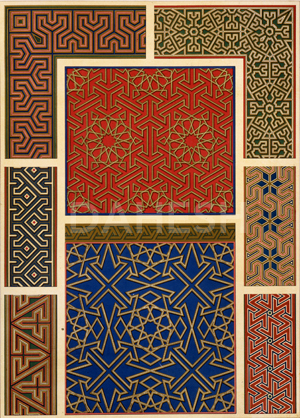After Achille-Constant-Théodore-Émile Prisse d’Avennes (French, 1807–1879)
Lithograph by Spiégel
From L’Art arabe d’après les monuments du Kaire depuis le VIIe siècle jusqu’à la fin du XVIIIe par Prisse d’Avennes. 3 vols. Paris, Ve A. Morel et Cie, 1877.
Arabesque: Assembled Wooden Compartments and Borders, vol. 2, pl. 94
Color lithograph, 19 1⁄4 x 13 3⁄4 in.
Printed lower left: Lith. par Spiegel / Vve A.MOREL & Cie, Libraires; lower center: Prisse d’Avennes; and lower right: Imp. Par Lemercier & Cie / Ordre de publication No
1999.10

The engineer, artist, writer, and renowned Egyptologist, Prisse d’Avennes published several books, including his colossal three-volume L’Art arabe. Published between 1869 and 1877, this extraordinary survey of Islamic architecture, decoration, and applied arts includes 200 large color and engraved plates, of which 137 are color lithographs—mostly after Prisse’s on-the-spot drawings. Prisse greatly admired the Islamic style, especially that of Egypt and Syria, and suggested that its superiority could save Europe from what he considered its current aesthetic banality. Like some of his other plates, Arabesque: Assembled Wooden Compartments and Borders is essentially a decorative invention with various architectural fragments showing the viewer how patterns could be used engagingly in different colors. To achieve his extraordinary opaque effects in these plates, Prisse employed the advanced printmaking technique of color lithography—a decision encouraged in large part by Owen Jones’s sumptuous two-volume publication on the Ahambra (1842–45).


